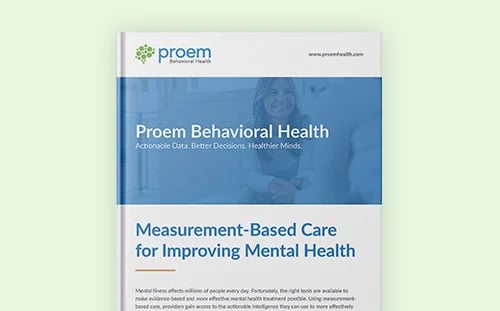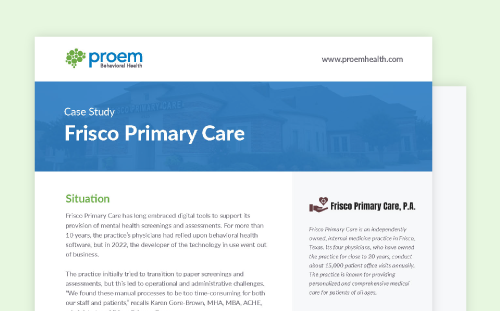
The prevalence of dangerous substance use has increased significantly in recent years, with the COVID-19 pandemic further accelerating usage. Key findings in the 2023 National Survey on Drug Use and Health (NSDUH) issued by the U.S. Department of Health and Human Services' (HHS) Substance Abuse and Mental Health Services Administration (SAMHSA) show that:
- In 2023, 3.1% of people (8.9 million) misused opioids in the past year, which is similar to 2022 and 2021 (3.2% and 8.9 million, 3.4% and 9.4 million respectively).
- Among the 134.7 million people aged 12 or older who currently used alcohol in 2023, 61.4 million people (or 45.6%) had engaged in binge drinking in the past month.
- Marijuana was the most commonly used illicit drug, with 21.8% of people aged 12 or older (or 61.8 million people) using it in the past year.
On a positive note, the use of substance abuse screening tools is helping make a difference in the lives of those battling substance abuse. Integrating routine substance use screening into all patient encounters can help all healthcare providers mitigate this crisis.
What Is SUD in Mental Health: Expanding How Providers View Substance Use
Clinicians must realize the importance of screening patients for substance use disorders (SUDs), whether those patients show traditional warning signs. In an article published by the American Psychological Association (APA), Dr. Aaron Weiner, president of the Society of Addiction Psychology, states, “People are misusing substances far more now than in recent memory, and a lot of independent practitioners may not have a structured clinical interview system in place, so these sorts of things may very well be slipping by. Simply asking the question and then knowing what to do if someone said yes could help connect someone to help for a problem that, if you can get to it early, doesn’t have to grow into something that becomes a chemical dependency or an overdose.”
Awareness of substance use allows providers to see beyond the binary distinction of disordered versus non-disordered. Many people have risky substance use habits but don’t meet the diagnostic criteria for dependence or addiction. Providers can benefit from adopting a screening model that understands this spectrum and helps identify the proper intervention at the right time.
The following five tips can help providers better achieve this important goal.
Tip #1: Implement A Three-Phase Model for Substance Use Disorder Assessment
To aid in effectively screening a broader population, APA is moving toward a more integrated public health approach to SUD intervention and treatment that follows three phases:
- Screening
- Brief intervention
- Referral to treatment
Together, these components comprise the acronym SBIRT. Applicable in primary care, emergency rooms, trauma centers and other community settings, the SBIRT approach empowers healthcare providers to quickly assess the need for substance use intervention.
SBIRT works like a funnel. The screening phase uses brief, one- to three-question tools to identify potentially risky behaviors. If the patient’s answers to substance abuse evaluation questions indicate risk, the provider can use a more in-depth tool to evaluate their awareness level and openness to change.
This is the “brief intervention” phase. Here, the provider uses motivational interviewing to focus on the patient’s goals and determine whether and how their substance use interferes with those goals. When this phase identifies an individual who needs specialty care and is motivated enough to benefit from such services, the provider moves on to the referral-to-treatment phase.
This stepwise approach increases the likelihood of early intervention, especially for individuals who wouldn’t otherwise present with higher SUD risk.
Tip #2: Integrate Screening for Co-Occurring Disorders
Substance use disorders are significantly more prevalent in people with mental health conditions. For example, a survey from the Substance Abuse and Mental Health Services Administration (SAMHSA) found that of the 47.6 million adults in the United States with any mental illness in the past year, 9.2 million — or about 19% — also had an SUD, whereas 5% of those without a mental illness had an SUD.
Routine mental health screening and assessments help providers and substance use disorder clinics identify SUD and co-occurring mental health disorders. For example, a patient with a history of major depressive disorder may present with worsening symptoms brought on by increased alcohol use. Without an alcohol screening, the clinician may miss an SUD diagnosis and only treat depression.
Likewise, patients with clear signs of disordered substance use may also experience heightened levels of depression and anxiety. Substance abuse screening tools reduce the risk that providers will mistake symptoms of those conditions for manifestations of substance use.
Tip #3: Implement Universal Screening to Improve Patient Outcomes
SAMHSA points to routine screening and assessment as essential steps in promoting positive outcomes. According to the organization’s Treatment Improvement Protocol, “[The] multistep process is designed to help counselors thoroughly explore all areas of clients’ history, symptoms, functioning, readiness for treatment and other service needs so that treatment decision-making is fully informed and tailored to each individual’s clinical situation. In short, without timely and effective screening and assessment, the chances of clients receiving appropriate care decrease significantly.“
Correct diagnosis is the first step to treatment, and too many people with substance use problems don’t get the treatment they need. In a 2021 survey by SAMHSA, nearly all patients who declined substance use treatment reported they didn’t need it, yet 16.5% of individuals met the diagnostic criteria for an SUD. In all, 94% of adolescents and adults with substance use disorders received no treatment.
Without treatment, SUD patients are vulnerable to poorer outcomes — medically, emotionally and socially. For example, disordered substance use increases the risk of accidental injury, overdose and attempted suicide for patients from adolescence through older adulthood. In adult patients, substance use increases the risk of mental health conditions and medical issues such as heart disease and some cancers. Ongoing drug use also increases the likelihood of congenital disabilities and neonatal “withdrawal” for children of mothers with addiction.
Tip #4: Establish Trusting Relationships with Patients
Research indicates that identifying a patient’s stage of change and readiness to engage in services can help inform treatment planning and optimize adherence and outcomes.
SUD clinics and providers can add a uniquely personal element to the screening process. They often have an established caring relationship that allows them to interpret screening results and follow up in a sensitive way. By showing compassionate curiosity when asking substance abuse evaluation questions, providers can encourage patients to disclose substance use habits and indicate their desire to change them.
In some cases, providers can nurture this desire for change and offer support to uncertain patients. Such support could be the factor that convinces the patient to seek help and follow through on receiving it.
Tip #5: Use Evidence-Based Substance Abuse Screening Tools
Each phase of the SBIRT process uses an evidence-based approach to ensure accuracy and objectivity. For example, standardized questionnaires reduce unconscious bias in interviewers and allow all screened individuals to answer the same question. Standardization is essential because even a seemingly minor phrasing change can alter the question’s perceived meaning.
The move to digitization is also a significant development. Digitized tools, such as those in the Proem software platform, enable providers to integrate SUD and mental health disorder screening into their existing workflows while giving patients an easy and non-confrontational way to engage with their providers.
Bring Effective Screening Tools to Your Practice with Proem
Standardized substance abuse screening tools provide more accurate screening and treatment of substance use disorders. Proem Behavioral Health supports healthcare providers and SUD clinics by offering accessible, customizable behavioral health and SUD tools that integrate seamlessly into existing workflows. These digital screening tools allow providers to assess, diagnose and track patients for disordered substance use and other, often co-occurring, mental health disorders.
Proem has designed these tools to be applicable to current SUD and mental health challenges, thus allowing providers to better serve as many community members as possible. Contact us today to learn more about how Proem can support your commitment to your patients’ overall health.





.png)









